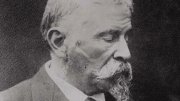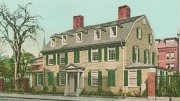Looming large. Henry Lee Higginson, A.B. 1855, LL.D. 1882, left a huge mark on Boston (he founded the symphony) and Harvard (he joined the Corporation in 1893). With investors, and no help from his alma mater, he assembled and held in trust the industrial land across the Charles River, intended to house a new MIT campus, that became the site for the Business School, and he personally donated Soldiers Field, for athletics—the essential steps into Allston. He also organized the purchase of the downtown site for the Medical School.
In 1899, Higginson donated $150,000 for construction of the Harvard Union, a center intended to welcome all in a clubbable era of sharp socioeconomic divisions. It later served for decades as the first-year students’ dining hall.
The Union has since morphed into the Barker Center, home to Harvard’s humanities scholars. Elizabeth Randall, who was project manager for the renovation of the complex (she’s an independent consultant now), retains an interest in its history, and has brought to Primus’s attention an unheralded aspect of Higginson’s forward thinking. On October 8, 1909, writing from 44 State Street, he addressed the new president, A. Lawrence Lowell: “Miss Milholland is sitting in my office and has seen you, who know her errand as well as I. I have stated to her all the objections to her being a student in our law school, just as you…no doubt have.” Then he advanced her case:
“I do not know whether it is within our charter to admit her as a student, and I do not know how much it would interfere with our work. I have always supposed that this thing must come some day—that we must admit women to our law school—all the more, that we hold it so high in quality and efficiency. If you gentlemen think it worth while, or rather wise, to admit her as a student, I shall be quite content.…
“If we are to begin at all with women, we certainly can do no better than with this young lady. It is, however, to be remembered that men are being gradually displaced by women, and if they are all like this young lady, it would merely hasten our banishment.”
Lowell is better known today for his notorious quota on admission of Jewish students to the College, and homophobia—and the law school did not admit women until 1950. But one has to admire Higginson’s advocacy, a century ahead of today’s institutional focus on diversity and inclusion.
• • •
Fellowship effect. For many a professional, a fellowship year at Harvard is a blessing: a break from career demands to think and reboot. But are the returns on the intellectual investment real? Hard to say in general, but a recently encountered testimonial is revealing.
Working, a 2019 collection by Robert A. Caro, a Princeton alumnus and 1966 Nieman Fellow, relates how at age 29, on leave from Newsday, he came to realize something about his emerging project on Robert Moses and the politics of reshaping twentieth-century New York City. “And the more I thought,” he said in a Paris Review interview included in the book, “the more I realized, My God, I’m never going to be able to do this in the context of daily journalism.…It’s going to take a book.” Some book: the gargantuan, Pulitzer Prize-winning The Power Broker, an unequaled narrative on, among other things, the neighborhood-destroying reality of jamming highways into an existing urban fabric, while accommodating the interests of those rich and connected enough to keep out of harm’s way.
Beyond that invaluable time to take stock, Caro relates, in another section adapted from a lecture, how his Harvard studies in urban planning perversely shaped the book’s trajectory:
“One of my courses was taught by two professors who had written a well-regarded textbook on highways, including an analysis, in great detail, of…why highways get built where they’re built. They were doing this by means of a mathematical equation. There were factors such as population density, traffic patterns, elevation of grades….And at each class they would write the equation on the board and then they would add new factors to it. And the equation was getting quite long.…I was being a very diligent note-taker in this course and writing everything down. And then one day, while I was taking notes, I suddenly thought, No, that’s not why highways get built where they get built. They get built there because Robert Moses wants them there.”









